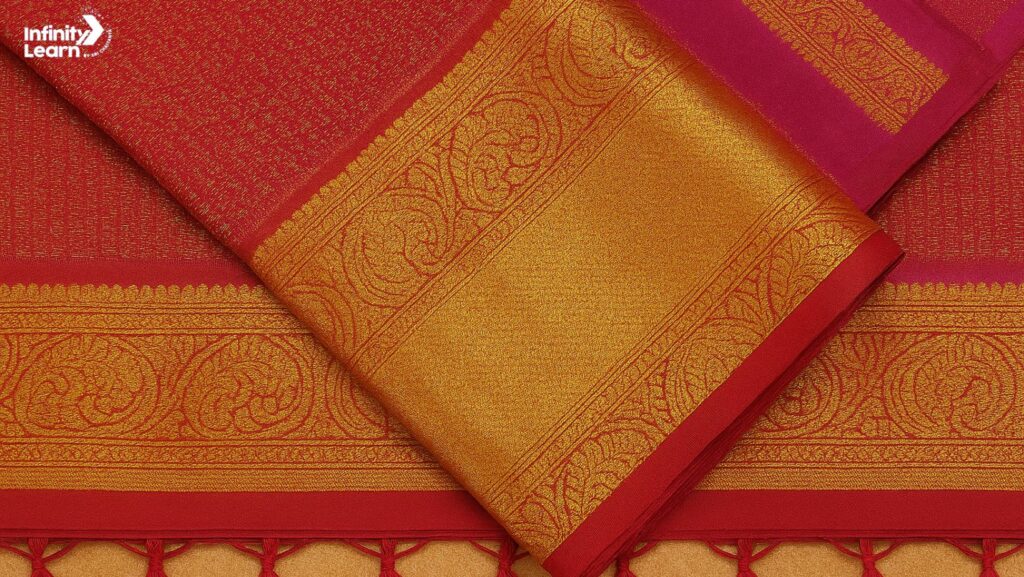Table of Contents
Kanjivaram silk sarees are one of the most exquisite and traditional garments in Indian culture, known for their grandeur and elegance. Authentic Kanjivaram sarees are made from pure silk, usually from the South Indian town of Kanchipuram. But with the rise of imitation and synthetic materials, it’s important to know how to distinguish a genuine Kanjivaram saree from fake or low-quality versions.

Key Features to Identify a Pure Kanjivaram Silk Saree
1. Pure Kanjivaram Silk Features
- Texture and Feel: Pure Kanjivaram silk has a rich, smooth, and lustrous texture. It should feel heavy and soft to the touch. The fabric’s shine will be radiant, without being overly glossy, as seen in synthetic silk.
- Durability: Kanjivaram silk is known for its durability and can last for generations when taken care of. If the fabric feels light or flimsy, it may not be pure silk.
2. Zari Work
- Gold and Silver Zari: Kanjivaram sarees are famous for their intricate zari work, typically made with real gold or silver threads. Authentic zari will not tarnish easily, unlike fake zari that may lose color or shine.
- Heavy Zari Borders: The borders of a Kanjivaram saree are often adorned with heavy zari work, a signature feature of this saree. Fake sarees often have lighter, machine-made zari.
3. Border and Pallu
- Rich Borders: The border of a pure Kanjivaram saree is often wide, with bold patterns and traditional motifs. Kanjivaram sarees typically have contrasting borders that are distinct from the body of the saree.
- Pallu Design: The pallu (the part of the saree draped over the shoulder) is usually intricately woven with unique designs and motifs. Pure Kanjivaram pallu designs often showcase traditional elements like temples, peacocks, and elephants, meticulously handwoven.
4. Weight and Feel
- Heaviness: A Kanjivaram saree made of pure silk is heavy compared to synthetic counterparts. If you pick up the saree and it feels unusually light, it might not be genuine.
- Thickness of the Fabric: Pure Kanjivaram sarees are woven from multiple threads, which give the fabric a thicker, richer feel. It should feel substantial when draped, without feeling stiff.
5. Weaving Technique
- Handloom Weaving: Kanjivaram sarees are typically woven on handlooms, and the intricate process involves weaving the saree with multiple threads. The weave should appear tight and uniform with no loose ends.
- Check for a Small Gap in the Border: A characteristic of authentic Kanjivaram sarees is a small gap or break in the border design. This is because the border is woven separately and then joined to the body of the saree during the final stage of the weaving process.
6. Color and Dyeing
- Rich Colors: Kanjivaram sarees are dyed using traditional methods, resulting in vibrant and long-lasting colors. If the saree colors appear dull or uneven, it could be a sign that the silk isn’t pure or the dyeing method isn’t authentic.
- Color Fastness: When you gently rub the fabric, the dye should not rub off or fade, which is a common trait of low-quality materials.
7. Price and Brand
- Cost: Pure Kanjivaram silk sarees are expensive due to the quality of the silk and the labor-intensive weaving process. If the price seems too good to be true, it’s likely that the saree is not pure Kanjivaram.
- Reputable Brands: When buying, opt for well-known, reputable brands or stores specializing in Kanjivaram silk sarees. They usually offer certification for authenticity.
How to Identify a Pure Kanjivaram Silk Saree Online
With the convenience of online shopping, it can be difficult to assess the authenticity of a Kanjivaram silk saree without physically inspecting it. However, there are several strategies you can use to ensure you’re buying a genuine saree online:
1. Check for Certification
- Many authentic sellers provide certifications for the authenticity of their Kanjivaram silk sarees. Look for labels such as “Handloom Mark” or “Silk Mark” to verify the purity of the silk.
2. Look for Detailed Product Descriptions
- A reputable online seller will provide in-depth details about the saree, including the type of silk, the weaving method, and the specific zari used. Make sure they describe the fabric weight, the weave, and the design to help you gauge the quality.
3. Read Customer Reviews
- Customer reviews are an excellent resource when buying a Kanjivaram silk saree online. Check for feedback on the authenticity of the saree, its quality, and the overall shopping experience. If several customers mention that the saree was of poor quality or different from what was advertised, it’s best to avoid that seller.
4. Check High-Resolution Images

5. Verify Return and Exchange Policies
- Ensure the online store has a flexible return and exchange policy. A trustworthy seller should allow you to return or exchange the saree if it doesn’t meet your expectations in terms of quality or authenticity.
6. Pricing and Discounts
- Be cautious of deep discounts or prices that seem too low. Authentic Kanjivaram sarees are priced based on their craftsmanship, material, and intricate weaving. Extreme markdowns might indicate that the product is not genuine.
7. Check the Seller’s Reputation
- Buy from established and trusted online platforms or boutiques specializing in silk sarees. Platforms with a history of selling authentic traditional garments are more likely to offer genuine Kanjivaram sarees.
How to Identify a Pure Kanjivaram Silk Saree Offline
When shopping for a Kanjivaram silk saree offline, it’s important to physically inspect the saree to confirm its authenticity. While online shopping has its own challenges, buying offline gives you the advantage of direct tactile experience with the fabric. Here’s a guide to help you identify a pure Kanjivaram silk saree when shopping in stores:
1. Feel the Fabric: Texture and Weight
- Heavy and Substantial Fabric: One of the most noticeable features of a pure Kanjivaram saree is its weight. Pure silk Kanjivaram sarees are heavy because they are woven with multiple threads, making them thicker and more substantial than imitation sarees. When you pick up the saree, it should feel dense and heavy, not light or flimsy.
- Smooth, Soft Texture: The fabric of a pure Kanjivaram saree feels soft and smooth to the touch. Rub your fingers gently over the surface. The pure silk will glide smoothly without any roughness.
2. Check the Zari Work
- Authentic Zari: Pure Kanjivaram sarees are known for their intricate zari work, which is traditionally done with real gold or silver threads. Zari in a genuine Kanjivaram saree will have a beautiful, radiant shine and should not tarnish or fade easily. When inspecting the zari, ensure it looks rich and lustrous.
- Thick Zari Borders: The zari work on the borders of a Kanjivaram saree should be thick and bold. If the zari feels thin or the borders look flimsy, it could be a sign of a counterfeit or lower-quality saree.
3. Examine the Pallu and Borders
- Intricate Pallu Designs: A hallmark of Kanjivaram sarees is the intricacy of their pallu designs. The pallu is typically adorned with traditional motifs such as temples, peacocks, and flowers, all handwoven with great attention to detail. When inspecting the pallu, look for symmetrical patterns, well-defined motifs, and high-quality weaving.
- Distinct Borders: The borders of a Kanjivaram saree are often bold and in sharp contrast to the body of the saree. The borders are also usually woven separately and then attached, which can be identified by a small gap or seam at the joint.
4. Check the Weaving Technique
- Handloom Weaving: Kanjivaram sarees are traditionally woven on handlooms, and this gives them a distinct texture that is absent in machine-made sarees. The weaving should be tight, dense, and uniform. If you feel any loose threads or if the weave feels too loose or uneven, the saree may not be a genuine Kanjivaram.
- Double Warp Technique: A pure Kanjivaram saree is woven using the double warp technique, where two threads are used to weave the saree. This technique contributes to the durability and rich texture of the fabric. If you inspect the fabric closely, you may notice the distinct texture that results from this technique.
5. Observe the Color and Dyeing
- Vibrant and Rich Colors: Kanjivaram sarees are known for their vibrant colors, which are derived from natural dyes. These colors are deep and long-lasting, and they do not fade quickly. If the color of the saree appears dull or uneven, it is likely not made from pure silk.
- Dye Fastness: A simple way to check the dye fastness is by gently rubbing the fabric with a white cloth or tissue. In a genuine Kanjivaram saree, the color should not bleed. If the dye rubs off or fades, the saree might not be authentic.
6. Check for the Signature Small Gap in the Border
- Unique Border Technique: One of the traditional features of Kanjivaram sarees is a small gap or break in the border, which is a result of the separate weaving process for the border and the body of the saree. This small gap is usually not visible from a distance but can be spotted by inspecting the saree closely.
- Sign of Authenticity: This gap is a distinguishing mark of an authentic Kanjivaram saree. If the border seems seamless or too perfect, it could be a sign that the saree is not traditionally woven.
7. Examine the Finish
- Finish and Edges: A pure Kanjivaram saree should have neatly finished edges. The border should not show signs of loose threads or fraying. The saree should look polished, with no visible imperfections in the weaving or stitching.
8. Price and Brand Reputation
- Consider the Price: Pure Kanjivaram sarees are a luxury product, and they come with a premium price tag. If the saree is being sold at an unusually low price, it’s likely that it is not authentic. You can expect to pay a higher price for genuine Kanjivaram silk due to the labor-intensive weaving process and the high-quality materials used.
- Reputable Sellers: Always buy from well-known, reputable stores or boutiques that specialize in traditional Indian silk sarees. These stores usually offer certification or guarantees of authenticity and are more likely to have a range of genuine Kanjivaram sarees.
9. Burn Test
- Simple Burn Test: If you’re still unsure about the authenticity of the saree, you can perform a simple burn test. Take a small piece of thread from the saree (preferably from the edge) and burn it. Pure silk will burn slowly and produce a smell similar to burning hair, leaving behind a small, brittle ash. Synthetic fabrics, on the other hand, will melt and produce a chemical smell. However, be cautious when performing this test, as it will damage the fabric.
Conclusion
Identifying a pure Kanjivaram silk saree requires attention to detail, knowledge of its characteristics, and an understanding of the authentic weaving techniques. By focusing on factors like fabric texture, zari work, weight, and weaving techniques, you can easily distinguish a genuine Kanjivaram saree from imitations. When shopping online, always ensure the credibility of the seller, check for certifications, and read reviews to confirm the authenticity of the saree. By keeping these tips in mind, you can confidently add a stunning, authentic Kanjivaram silk saree to your wardrobe.
FAQs on How to Identify a Pure Kanjivaram Silk Saree
How can you tell a real Kanjivaram saree?
A real Kanjivaram saree features heavy, rich silk with vibrant colors, distinct zari work, and detailed handwoven borders. The pallu often has intricate designs like peacocks, temples, and florals.
How to identify an original silk saree?
Original silk sarees are soft, shiny, and smooth. You can do a burn test—pure silk burns slowly and smells like burning hair.
What is the difference between Kanjivaram and pure silk saree?
Kanjivaram sarees are from Tamil Nadu with unique weaving and zari work, while pure silk sarees can be from anywhere and may not have such intricate designs.
What is the starting price of Kanjivaram saree?
The starting price of a Kanjivaram saree is ₹8,000 to ₹15,000 depending on silk quality, zari, and design.
How much does a pure Kanchipuram saree cost?
Pure Kanchipuram sarees start at ₹10,000 and can go up to ₹50,000 or more based on silk quality and zari work.
Which is costly, Banarasi or Kanjivaram?
Kanjivaram sarees are usually costlier due to heavier silk and intricate weaving, though both are luxurious.
How to identify pure Kanjivaram saree online?
Look for 'Silk Mark' or 'Handloom Mark,' detailed product info, and buy from trusted sellers with good reviews.
How to check if a Kanchipuram silk saree is original or fake?
Check for heavy texture, intricate zari, and handwoven finish. Fake ones feel light and synthetic.
How to check the purity of silk sarees?
Do a burn test—pure silk burns slowly and smells like hair. It also feels smooth and has a natural sheen.
How to check original Kanjivaram saree?
It should feel thick with rich silk, heavy zari borders, and a shiny finish. Look for handloom marks.








